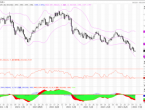The standoff of the US debt crisis has been suspended, but the US stock market is picking up and Wall Street is not anxious to take action?
On Wednesday (October 6), the U.S. Senate seems to be expected to reach an interim agreement on the debt ceiling. As investors are more optimistic that the U.S. Congress may reach an agreement, the U.S. stock index continues to rise. For a long time, U.S. stock investors have adopted the strategy of buying on dips. However, the debt crisis has not yet been truly resolved, and the risk of the Fed’s tightening policy is expected to bring about a more substantial correction in the stock market. Wall Street analysts believe that buying on dips may be feared. It's not yet time.
U.S. stocks rebounded, but there are still risks lurking
Ryan Detrick, chief market strategist at LPL Financial, said that since the beginning of 2012, the S&P 500 has seen 25 corrections of at least 5%. During this period, the index has risen by more than 240%, providing reasons for investors to be willing to intervene when the stock market is weak.
The act of looking for low prices is already obvious. Since Monday, the S&P 500 has rebounded by about 1%. The sharp sell-off at that time caused the index to close more than 5% below the record closing high, which is the biggest drop since 2021. According to data from Vanda Research, these buyers include retail investors, who have bought an average of $1.2 billion in stocks per day so far this week, which is above average.
Marko Kolanovic, a strategist at JPMorgan, said on Wednesday that the epidemic has "effectively ended" and urged investors to buy economically sensitive cyclical stocks that would benefit from the broader economy. improve.
However, there are also concerns that the short-term risk of buying in this round of decline may be greater than in the past. In addition to the protracted struggle of congressmen to raise the US debt ceiling, investors also face the imminent withdrawal of the Fed from 1,200 per month. The risks of a billion-dollar Treasury bond purchase plan.
Shawn Snyder, head of investment strategy at Citi US Wealth Management, said that the heated debate among US congressmen over raising the debt ceiling or letting the US fall into default is the main near-term risk facing the stock market. Snyder said: "The bargain hunting strategy is still effective, but there are still very specific issues that need to be addressed first."
The U.S. Senate seems to have a brief truce, but the debt crisis has not yet been resolved
The US Senate seems to be about to reach an interim agreement to avoid a federal debt default in the next two weeks. Earlier, Democrats said on Wednesday (October 6) that they might accept a proposal from the Republican Party to resolve the deadlock between the two parties and avoid threatening the broader economy.
The Democrats canceled the early afternoon vote. The bill will postpone the debt ceiling until December 2022, when the midterm elections will determine which party controls Congress in the next two years. Earlier, Senate Republican leader Mitch McConnell (Mitch McConnell) proposed a plan that will buy more time to solve this problem. McConnell proposed that the Republican Party will allow the federal debt ceiling to be extended to December.
Some Democrats said they would accept this proposal. Democratic Senator Tammy Baldwin said: “We intend to accept this temporary victory.” However, since Senate Democratic Leader Schumer did not issue a statement, it is unclear whether this is the party’s official position, and the White House has not promised to support this. One idea. White House spokesperson Jen Psaki said that the White House has not yet received a formal proposal.
However, even if this proposal is reached, Democrats will have to resolve this issue again in December, because federal funds are about to expire. This may complicate their efforts to pass two huge spending bills, which occupy a large part of Biden's domestic agenda.
Republicans said that Democrats may use the intervening weeks to pass a settlement process and pass a bill to extend the debt ceiling. Democrats believe that the settlement process is too cumbersome and too risky. McConnell said that Republicans will make concessions to help speed up the process.
In less than two weeks, the Ministry of Finance will be unable to pay government expenditures. The Bipartisan Policy Centre said on Wednesday that if the debt ceiling is not raised, unemployment insurance payments, wages for millions of federal employees, and health insurance payments may be delayed. Analysts said that a debt default could disrupt the global financial system and cause millions of people to lose their jobs.
Even if you get out of danger by chance, it can cause damage. In 2011, the US Congress resolved the debt ceiling dispute two days before the debt ceiling was about to be reached, causing the stock market to plummet and leading to the first downgrade of the US debt credit rating. However, Moody's Investors Service said on Tuesday that it expects the US government to eventually raise the debt ceiling. On Wednesday, the U.S. stock index rose as investors were more optimistic that the U.S. Congress might reach an agreement.
On the other hand, the yield on the one-month Treasury bond has fallen sharply, and this type of security is most likely to suffer from the government’s failure to pay the interest or principal of the debt immediately after the deadline. The new buying shows a rebound in investor confidence.
Fed tightening policy may bring more than 10% callback
Analysts at BofA Global Research warned on Tuesday that as the Fed prepares to gradually withdraw from loose monetary policy, the situation seems far from clear. Loose monetary policy has helped the market double from its August low last year. Bank of America's target price in the Standard & Poor's 500 Index is 4250 points, which is about 2% lower than Tuesday's closing price.
The possible risks of a tougher Fed also worries analysts at Morgan Stanley, who said on Monday that if the economy and earnings "cool down" as the Fed tightens policy, the S&P 500 index may fall by as much as 20%.
A scenario outlined by Morgan Stanley's strategists is that as the Fed tightens monetary policy due to rising inflationary pressures, the S&P 500 index will fall by about 10%. In the second scenario, as the Federal Reserve tightened its policies, economic and income growth slowed, causing the economy to decline by 20%. Morgan Stanley analysts said: "The final conclusion is: faster tightening and greater growth deceleration means more than 10% adjustment."
Despite these concerns, historical evidence shows that markets driven by strong momentum tend to continue to rise. According to LPL’s Detrick, in the years where the S&P 500 index rose more than 12.5% in the first nine months of this year, the fourth quarter’s rise accounted for nearly 80%, and the median fourth-quarter increase was 5.2%.
Seasonal trends may also provide reasons to buy early and buy late. Although September’s decline reached 4.8%, which is worthy of being the weakest month in history, October’s performance has traditionally been stronger. According to Stock Trader’s Almanac, the average increase in the S&P 500 index has been since 1950. The seventh highest.
According to the yearbook, November's monthly performance ranked second, with an average index increase of 1.7%, and December ranked third, with stocks rising 1.5%. At the same time, J.P. Morgan’s Kolanovic said that investors should take advantage of the recent stock market pullback to buy stocks in emerging and developed markets, with the exception of high-growth and technology stocks.
On Wednesday, the three major US stock indexes rose for the second consecutive trading day, and the S&P 500 index closed at 4,363.55.
(S&P 500 index daily chart)











